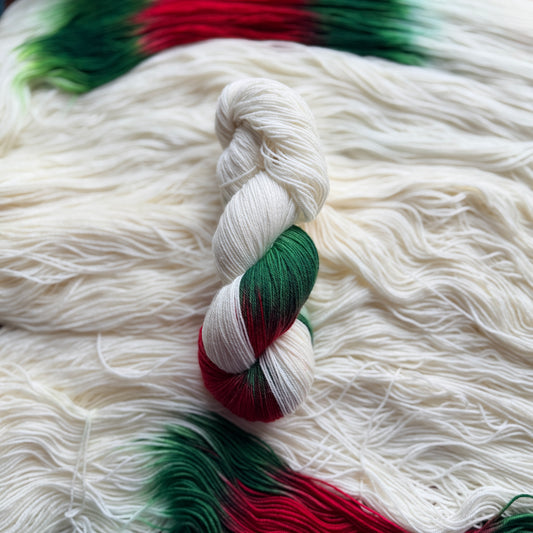Christmas Pudding Baby Sweater
To share

Introduction
This pattern is more a type of blueprint, a description on how to modify basically every top-down raglan sweater pattern into this cute Christmas version. As baby sweaters are so tiny, they knit up quickly and make for the perfect last minute Christmas gift. Fun fact: does your stranded color work tend to pucker because your floats are too tight? Well, with this pattern it will only add to the authenticity because it will only make the sweater look more like a tiny crumpled Christmas Pudding. Ok, let's go!

Pattern
First, choose your favorite go-to baby sweater pattern. It can be any pattern you like, as long as it's knit top-down in the round and as long as it's knit on needle size US4 or US5 / 3.5-3.75mm. A pattern with raglan increases is easiest to use but round yoke constructions can be used to by the more advanced knitters among us.
Yarn
For this pattern, I've used the same yarn base (Auridon Yarns Deluxe Merino Sock; 85% SW merino wool 15% nylon, 400m/100g) in three different colours:
- 'Holly' (assigned pooling)
- 'Christmas Pudding' (brown variegated)
- Undyed white
The yarn I've used is available for purchase here but if you're on a budget, you can always use any white sock yarn you like, combine it with a brown of your choice and add the little textured holly pieces later on. Warning: this would create lots of ends to weave in!
Yardage used for a sweater size "1-2yr": Holly Assigned Pooling 16g/65m/71y, Christmas Pudding 40g/160m/175y, Undyed white 40g/160m/175y

How to make a Holly Cluster Stitch?
Check out my YouTube tutorial on how to make the Holly Cluster Stitch here . The Holly Cluster Stitch is a 3-row texture motif where stitches are gathered to form small “berries”
Cast-on & Neck
Choose your desired sweater size and cast on the needed number of stitches in the plain white yarn. Follow the instructions given by the pattern.
For me, this was 88 stitches. The pattern recommends using a US2 / 2.75mm needle but I've used a US1 / 2.25mm instead because I find it gives an even prettier ribbing.
Yoke
Now it's time to break the white yarn and switch to the assigned pooling yarn. Using this yarn, knit the entire yoke ( but stop three rows before the end!) by following the instructions from the pattern. Keep in mind that you want to avoid placing the cluster stitches exactly where your increases are. Try to get creative with the increases when you have to: postpone them for one row or - even better - try to incorporate them in the cluster stitch by decreasing one less stitch. Break the yarn and switch to the white yarn again.
Knit the last three rows in the plain white yarn, rounding up the cluster stitches from the previous rows as you go. This will make sure that the transition from the icing to the cake is more crisp looking and there won't be any cluster stitches on the edges.
I ended up adding two more rows in the white yarn to the yoke in the end because I felt it would give just that tiny bit of extra comfort to my baby.
Split the body & sleeves
Just do what the pattern tells you to do, use the white yarn whilst doing so.
The dripping icing - the body
Now for the hardest part of this: the dripping icing on the cake! There is going to be some stranded color work here using both the white and the variegated brown colored yarns. You can have some small repeats of 7 stitches wide (Chart A), some medium sized ones - 9 stitches (Chart B) and some large of 13 stitches wide (Chart C). Please pay attention to both tension (most people need to go up or down a needle size when doing color work) and to yarn dominance - the white yarn is the dominant color here. ( What is yarn dominance? )
I now have 132 body stitches on my needles and I want to create a nice but not too busy dripping pattern. I shuffled the numbers around a bit and found out that I can do 8 x 13 stitches (= 104) plus 4 x 7 stitches (= 28), so I need to do 8 repeats of Chart C and 4 repeats of Chart A.
(If you don't like the number puzzle, check out this table I made here . I calculated the numbers 40 to 200. There's more than one right answer for many of them, so don't let my calculations limit you but if you want a quick answer, no need for math stress.)
 Chart A (7 pcs)
Chart A (7 pcs)
 Chart B (9 pcs)
Chart B (9 pcs)
 Chart C (13 pcs)
Chart C (13 pcs)
After knitting the Chart repeats, continue in the Christmas Pudding colored yarn and finish the body following the pattern's instructions.
The sleeves
Similarly to the body, start out with some 'icing' and repeat charts A, B and/or C and finish the sleeves in the Christmas Pudding colored yarn following the pattern's instructions.
The pattern told me to do decreases on the sleeves which I postponed until after I was done with the charts. Doing stranded colourwork on tiny rows is HARD! I ended up using a stuffed animal stuck into my sleeve to keep everything in shape whilst knitting, which significantly improved my tension.
Finishing up
I've done some duplicate stitches in white to enhance the icing. Weave in the ends and steam block gently. I always wash my hand dyed yarns thoroughly to prevent bleeding, but with this sweater I didn't want to take any risk. I really wanted the white to stay crisp so I decided to gently steam block with an iron and a damp cloth to block.





